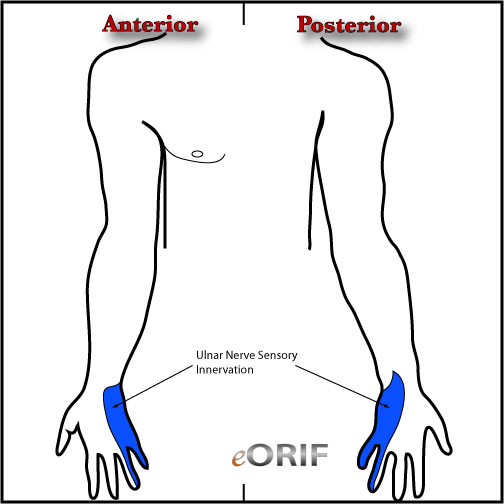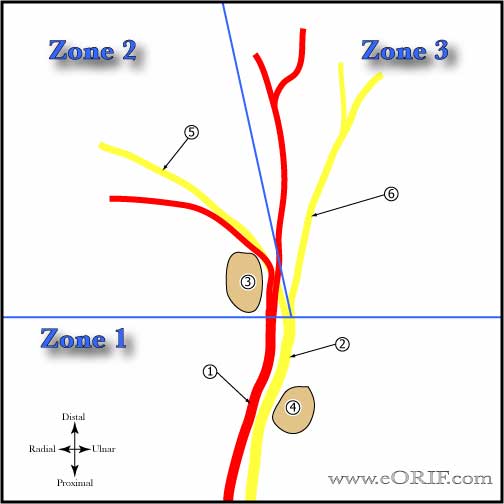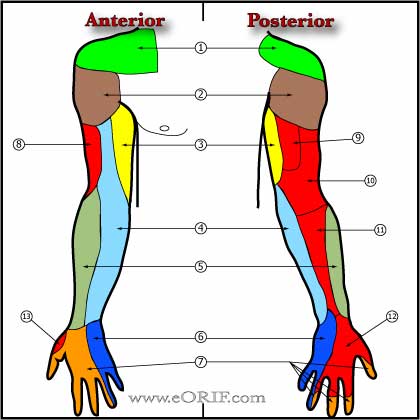|




|
synonyms:Guyons canal syndrome, handlebar palsy
Ulnar Tunnel Syndrome ICD-10
A- initial encounter
D- subsequent encounter
S- sequela
Ulnar Tunnel Syndrome ICD-9
- 354.2 (lesion of ulnar nerve; cubital tunnel)
- 955.2 (injury to peripheral nerve: ulnar nerve)
Ulnar Tunnel Syndrome Etiology / Epidemiology / Natural History
- ulnar nerve compression in Guyon's canal
- #1 cause=ganglion. Especially Zone 1 and 2.
- more common in cyclists
Ulnar Tunnel Syndrome Anatomy
- mixed=proximal, motor only=hook of hamate, pure sensory=distal to hamate
- roof=volar carpal ligament. Floor=transverse carpal ligament & pisohamate ligament. Ulnar wall=hook of hamate. Radial wall =pisiform &ADM muscle muscle.
- sources=ganglia(85%)(MRI), hook of hamate nonunion(CT), ulnar artery thrombosis(U/S), anomalous muscle, palmaris brevis hypertrophy
- Ulnar tunnel zone 1=proximal to bifurcation of nerve associated with mixed motor/sensory. Most common lesions = ganglions and hook of Hamate Fracture.
- Ulnar tunnel zone 2=hook of hamate, deep motor branch only. Most common lesions = ganglions and hook of hamate fracture.
- ulnar tunnel zone 3=superficial sensory branch only. Most common lesions = Ulnar artery thrombosis.
Ulnar Tunnel Syndrome Clinical Evaluation
- symptoms may be pure motor, sensory or mixed depending on location of compression
- Dorsal ulnar sided hand/wrist sensation is normal in Ulnar tunnel syndrome, if abnormal consider Cubital tunnel syndrome.
- Froments sign=FPL compensates for paralyzed adductor pollicis
- Jeanne's sign=compensatory hyperextension of thumb MP joint
- Document vascular exam (Allens test), if abnormal consider Ulnar artery thrombosis.
Ulnar Tunnel Syndrome Xray / Diagnositc Tests
- P/A and lateral views of the wrist typically normal.
- EMG/NCV
- MRI: consider to evaluate for space occupying lesions
- CTscan: best test to evaluate for hook of hamate fracture.
Ulnar Tunnel Syndrome Classification / Treatment
- Identiy etiology. Any identified compressive lesion should be removed, generally involves release of Guyon's canal, resection of any space occupying lesion, treatment of hook of hamate fracture, or revascularizing thrombosed ulnar artery.
- Conservative=activity modifications, splints, NSAIDS
Ulnar Tunnel Syndrome Associated Injuries / Differential Diagnosis
- Carpal tunnel syndrome(commonly coexist, release of transverse carpal ligament adequetely decompresses Guyons canal)
- Hypothenar Hammer Syndrome
- Cubital tunnel syndrome
- Wartenberg's Syndrome
Ulnar Tunnel Syndrome Complications
- Failure of decompression
- Persistent numbness
- Palmar hypersensitivity
- Distal Ulnar nerve palsy (motor branch)
- Wound dehiscence
- Infection
Ulnar Tunnel Syndrome Follow-up Care
- Post-op: Volar splint, NWB
- 7-10 Days: Remove sutures, consider night time splinting. Start gentle ROM exercises
- 6 Weeks: Begin strengthening exercises
- 3 Months:Return to full activities / sport
Ulnar Tunnel Syndrome Review References
|




